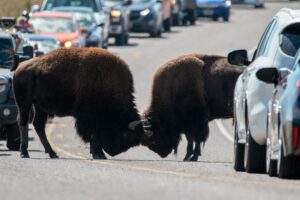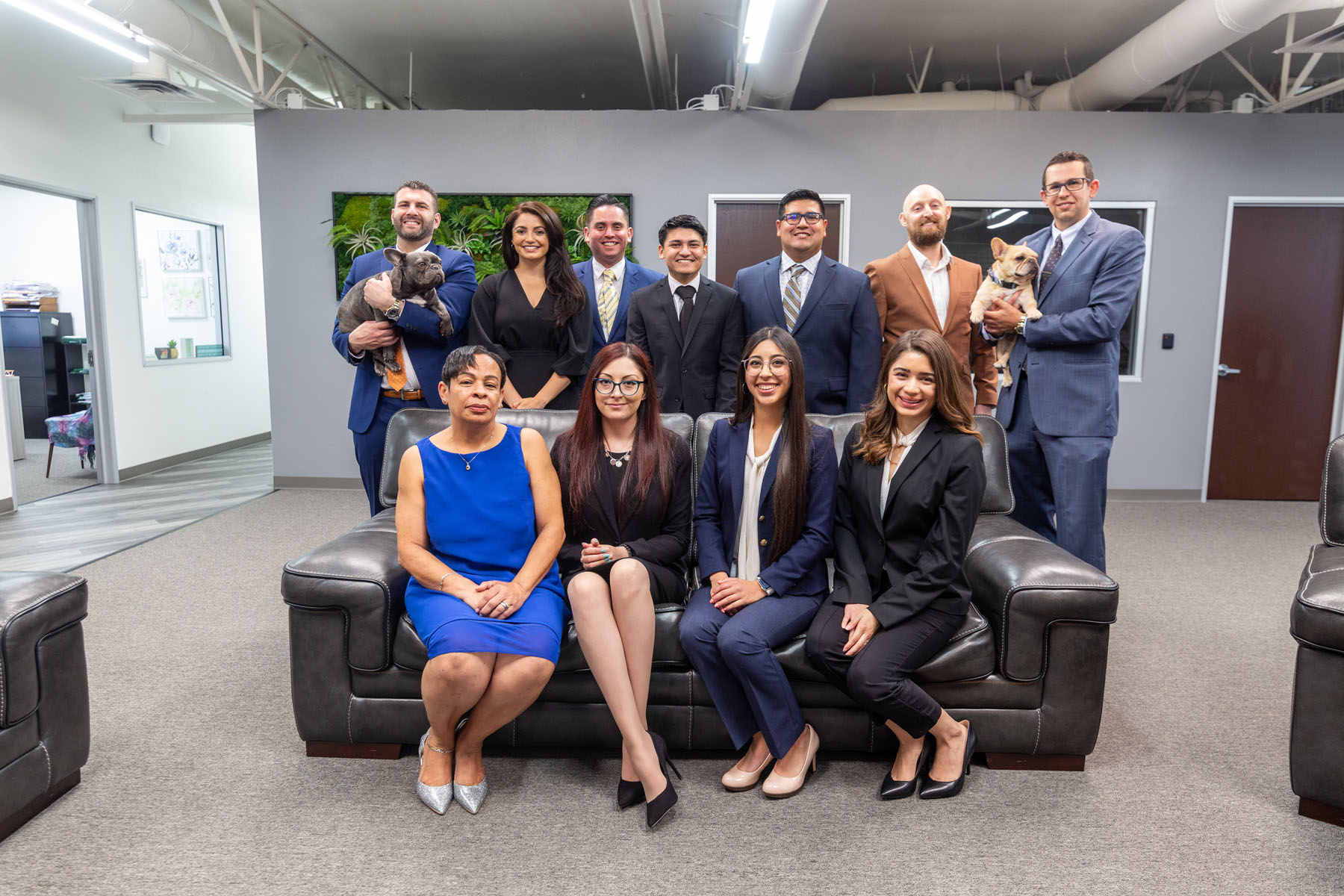Collisions with other vehicles are not the only dangers lurking on the roadway. Sometimes car accidents are caused by other sources, such as road hazards, animal crossings, slick surfaces, water, inclement weather, construction site obstacles, cargo that has fallen off vehicles, fallen trees or rocks, etc. Collisions due to road hazards can be just as harmful as collisions with other vehicles, causing injuries like spinal cord trauma, nerve damage, severe burns, fractures, whiplash, or even fatality.
Agricultural Hazards
Agricultural hazards can vary from machinery to animals. Most agricultural equipment is quite large in length and width, heavy, and slow-moving. Many smaller farms use equipment that are not up to date and may even be lacking proper lighting and hazard warnings. This would make it difficult to spot these machines in the early morning or in the evening. Similar issues arise with farm animals. They can be impossible to see without proper lights. These animals can sometimes be fast and dart across the street before you even notice them. If you see livestock on the roadway, slow down and take extra precaution.

Animals
Large Animals
Depending on where you live, collisions with large animals may be one of the more common roadway hazards. Larger animals that frequently cause roadway hazards include deer and moose. Pay close attention to animal-crossing signs and follow the speed limit. These types of animals are found to be most actively crossing the roadways at dawn and dusk. If you encounter a large animal on the roadway, it is typically safer to hit the brakes than to swerve. Some animals get caught in your headlights and others get confused by the vehicle swerving. Swerving your vehicle may put you in greater danger of hitting an oncoming vehicle or driving into a tree or barrier.
Small Animals
Though the potential danger of small animals on the roadway is much less than the potential danger of large animals on the roadway, small animals do still pose a threat. It is unfortunate to run into a situation where a small animal may be run over; however, when it comes down to it, it’s either the animal’s life or yours. If a small animal runs in front of you in the roadway, it is safer for you to hit the brakes on your vehicle than to attempt to swerve. Swerving your vehicle may result in a collision with an oncoming vehicle or driving into a barrier.
Bicyclists
A bicycle is considered a vehicle on the roadway and has the same rights as other vehicles. With bicycling being one of the most popular activities worldwide, collisions with bicyclists can be a common hazard on the roadway for both driver and bicyclist. If you notice a bicyclist on the road, give them plenty of space to ride. Be sure to slow down near them as well, and allow them to pass if they need to make a turn.
Large Vehicles
Large trucks can pose as a greater danger to regular passenger vehicles due to the difference in height and weight between the car and the truck. Large trucks, such as commercial trucks or delivery trucks, typically require further distance than a regular passenger vehicle to stop. These larger trucks also need more time to accelerate. If you are driving near a larger truck, please be sure to keep extra distance between your vehicle in the other truck and be prepared to slow or accelerate your speed to allow trucks to merge safely. As a general rule, if you cannot see the truck driver in the truck’s mirror, then the truck driver cannot see you. If the drier can’t see you, the chances of a collision increase greatly. Be sure to position your vehicle and stay away from the truck’s blind spots, so the truck driver can see your vehicle. In these situations, it is best to use common sense. Give them extra time to merge, don’t cut them off, and don’t drive too closely to them.
Motorcycles
Much like bicyclists, motorcyclists have the same rights as other vehicles on the roadway. Motorcyclists can sometimes be difficult to see in blind spots and due to the nature of the motorbike are more vulnerable to injuries in a collision. Give them extra space and careful consideration when driving near them on the roadway. It will protect both of you.

Pedestrians
Pedestrians sometimes pop up in unexpected areas on the roadway. Sometimes, pedestrians are found walking on the shoulder, tending to a vehicle on the roadway or shoulder, or trying to safely exit a dangerous situation on the roadway, like a previous crash. Without wearing reflective gear or night-sensitive clothing, it can be nearly impossible for drivers to see pedestrians. Unfortunately, in many instances by the time a drive does notice a pedestrian on the roadway, it may be too late.
Work Zone Hazards
Work zone hazards may include highway workers, traffic cones, road closure and speed reduction warning signs, construction materials, etc. To ensure safety when driving through a work zone, pay special attention to the roadway. Drive within the posted speed limits, avoid lane changing until you exit the work zone, turn your headlights on, and be aware of both workers and construction equipment or machinery.
Who’s Liable for Road Hazards?
When an unexpected road hazard causes a motor vehicle collision, determining liability can be a challenge. Man-made road hazards will fall on a negligence principle. Road hazards resulting from nature or “Acts of God” that could not be avoided. These can be nearly impossible to assign liability for, unless a governing body could have prevented or warned of the danger.
The majority of cases that involve road hazards will involve negligence. However, it can sometimes be difficult to pinpoint the person/entity responsible for the negligence. Hazards caused by construction projects may have been initiated by a public entity such as the federal or local government, a public agency. Others may have been the cause of projects initiated by private businesses, such as construction companies or landscaping companies. Whoever initiated the project may have had a duty to warn drivers and travelers on the roadway of potential hidden danger. Often, these warnings come in the form of a ‘warning’ sign or ‘reduce speed ahead’ sign. If a sign was not posted, it may be easier to find fault against the initiator. Another indicator of liability would be if an object rolled out of a construction vehicle into the roadway, causing a collision.
In other circumstances, liability may fall on the driver from a road hazard incident. Driver liability could be partial or full, affecting his or her compensation. States vary in how they award compensation based on fault.
- Comparative Negligence states – States that follow comparative negligence rules will assign percentages of fault to the parties involved. A plaintiff’s damages will then be reduced by the assigned portion of fault. Some states will allow recovery only if the plaintiff is less than 50% or 51% responsible for the incident.
- Pure Contributory Negligence states – States that follow pure contributory negligence theories bar a plaintiff from recovering any damages if it is assigned even 1% fault. In these circumstances, even if a defendant is 99% at fault, the plaintiff will be unable to be compensated for his injuries or damage to his vehicle.
Road Hazard FAQs
How can we avoid road hazards?
Road hazards are not always avoidable. However, there are a few ways to help keep yourself safe.
- Pay attention to the roadway. Keep your eyes on the road at all times, scanning the roadway ahead and peripherally for potential danger. Read the signs as you drive, picking up on any warnings.
- Avoid distractions. Stay off your phone, whether it’s talking or texting.
- Keep the radio down. Make sure the volume isn’t too loud when listening to music in the car. The volume should not drown out emergency sirens, car honking, etc.
- Lights, please. Keep your headlights on so the road is well-lit and your vehicle is visible to other drivers.
- Slow down. When you are driving in certain areas, it is safer for you and others to keep the vehicle’s speed down. Examples of areas to slow down in are school areas or areas where pedestrians would be crossing the road frequently, winding roads with rough terrain or mountain edges, and construction zones.
- Keep distance. Keeping distance between your vehicle and other vehicles can also give you time to reach should a hazard arise in the front of the vehicle in front of you.
What does “hazard” mean in driving?
A hazard is a source of danger. Hazards can be anything that may cause a driver to suddenly change speed, direction, stop, or even cause harm. Hazards can involve other road users (pedestrians, drivers, cyclists, etc.), environmental factors (weather, road surfaces, etc.), or physical (roundabouts, winding roads, etc.)
What are some hazards that are frequently seen on the highway?
Hazards common on highways include other drivers, abandoned vehicles, construction equipment, guard rails, narrow roads with no shoulder, temporary road barriers, temporary lane closures, tow trucks, work zones, wild animals, large commercial trucks, etc.
If you are involved in a road hazard incident…
- Preserve evidence. Make an effort to document the hazardous condition as soon as possible prior to leaving the scene. Hazards can often disappear as quickly as they appear, which would make it difficult for you or an insurance agent to investigate after the fact. Take photos or video; take notes; speak to any witnesses; call the police if necessary.
- Seek medical attention. If you or a passenger are injured, seek prompt medical attention. If your injuries are serious, call 911 and receive transportation by ambulance to a local emergency room. If your injuries are not as serious, it is still important to check in with your primary care provider within a few days of the incident.
- Talk to a personal injury attorney. If you are involved in a car accident due to a roadway hazard and have questions about your rights, contact an attorney to answer your questions.
Contact the team at Batta Fulkerson Law Group today to schedule a FREE one-hour consultation to review your case and available options.
What to expect in your Consultation Meeting:
- Collection of information about you to help assist you better
- Review of any court documents
- Review of what happened in your claim
- Explanation of court processes, fees, and what we can do to help your case.
Call Today or Book Online!




